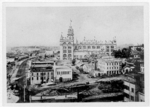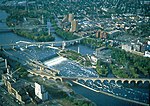Eastman tunnel

The Eastman tunnel, also called the Hennepin Island tunnel, was a 2,000-foot-long (610 m) underground passage in Saint Anthony, Minnesota, (now Minneapolis) dug beneath the Mississippi River riverbed between 1868 and 1869 to create a tailrace so water-powered business could be located upstream of Saint Anthony Falls on Nicollet Island. The tunnel ran downstream from Nicollet Island, beneath Hennepin Island, and exited below Saint Anthony Falls. During construction of the tunnel, on October 5, 1869, the river broke through the thin layer of limestone separating the river's bed from the tunnel. The rushing river scoured the tunnel, caving in parts of Hennepin Island and causing the earth supporting Saint Anthony Falls to collapse upstream. There was serious concern that the riverbed would crumble and reduce Saint Anthony Falls to a long set of rapids. Within a few weeks, dams were built to divert the river and stop Saint Anthony Falls from being washed away. The fix was temporary as the 1870 spring floods damaged some of the new dams and swept away more of Hennepin Island. The final fix for the tunnel disaster was a concrete dike constructed by the United States Army Corps of Engineers. The Corps also built a protective sloping wood timber apron to create an artificial falls which remain the only major waterfall on the Mississippi River. The Eastman tunnel is a contributing resource to the St. Anthony Falls Historic District. The District is on the National Register of Historic Places The site of the tunnel is about a mile upstream from site of the I-35W Mississippi River bridge that collapsed in 2007.
Excerpt from the Wikipedia article Eastman tunnel (License: CC BY-SA 3.0, Authors, Images).Eastman tunnel
West River Parkway Trail, Minneapolis
Geographical coordinates (GPS) Address Nearby Places Show on map
Geographical coordinates (GPS)
| Latitude | Longitude |
|---|---|
| N 44.984166666667 ° | E -93.2575 ° |
Address
Third Avenue Bridge
West River Parkway Trail
55415 Minneapolis
Minnesota, United States
Open on Google Maps










